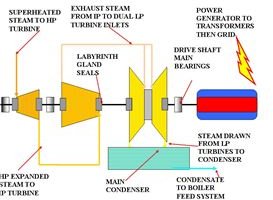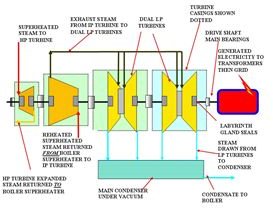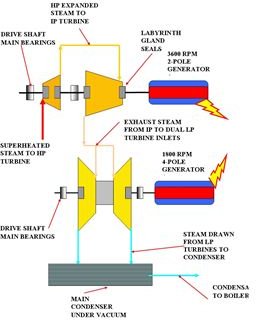Two types of Modern Steam Turbines and Their Mechanical Arrangements
The Two Types of Steam Turbines
The modern steam turbine can be divided into two types, impulse and reaction turbines. ·
- Impulse Turbines
In this type of turbine the superheated steam is projected at high velocity from fixed nozzles in the casing. When the steam strikes the blades (sometimes called buckets), it causes the turbine shaft to rotate. The high pressure and intermediate pressure stages of a steam turbine are usually impulse turbines.
- Reaction turbines
In this type of steam turbine the steam passes from fixed blades of the stator through the shaped rotor blades nozzles causing a reaction and rotating the turbine shaft. The low pressure stage of a steam turbine is usually a reaction type turbine. This steam having already expanded through the high and intermediate stages of the turbine is now of low pressure and temperature, ideally suited to a reaction turbine.
Although there only two types of steam turbine there are numerous mechanical arrangements of these, which include reheat steam turbines, cross compound steam turbines, single casing turbines, tandem steam turbines, condensing and exhaust steam turbines and, axial and radial flow steam turbines.
Mechanical Arrangements of Steam Turbines
In this article we shall examine the following mechanical arrangements of steam turbines, · Single casing steam turbine · Tandem reheat steam turbine · Compound steam turbine
Single Casing Steam Turbine
This is one of the simplest steam turbines and as the name implies has all its stages of steam turbines under the one casing. They are also all connected to a common drive shaft. The superheated steam is supplied to the high pressure turbine, entering it at the smallest diameter end and expanding through the turbine as the rotor blades get bigger until finally exiting and passing onto the intermediate stage. Here it also expands through the blades which are becoming larger towards the exit. These two stages are usually impulse turbines. From here the steam which is almost fully expanded enters the dual low pressure stage where it expands through the ever increasing in size rotor blades until at almost the last stage it is drawn into the condenser. This last stage is normally a reaction turbine.
Tandem Reheat Steam Turbine
This assembly consists of four stages all in line on the same shaft but can have several casings. The superheated steam enters the High Pressure stage (HP) where it expands through the small diameter rotor blades before exiting and being returned to the boiler. In the boiler the steam is superheated again and is directed to the Intermediate Pressure stage (IP). Here it expands through larger diameter rotor blades exiting to the Low Pressure turbines In the final stage there are two identical sets of Low Pressure turbines (Dual LP). The exiting steam from the IP turbine is divided equally between the two turbines passing through quite large diameter rotors and blades. The steam expands through both of the LP turbines by being drawn into the vacuum condenser.
Cross Compound Steam Turbine
An arrangement of these were popular marine turbines used for propelling ships, until being replaced by the more economical large two-stroke diesel engines. The marine turbines used a double reduction gearbox to reduce the normal high revolutions from the turbines to a propeller shaft rotation of around 100 revs. However, cross compound steam turbines used in power stations do not require a gearbox, having two separate direct drive-shafts to the two generators.
In a cross compound steam turbine the superheated steam enters the High Pressure stage, expanding through the rotor blades before exiting to the Intermediate Pressure stage, both turbine rotors being on the same drive shaft. This HP/IP turbine rotates at 3600rpm driving a 2 pole generator. The exiting steam now crosses over from the IP stage into the Low Pressure turbine, where it expands through the rotor blades, driving its own shaft and giving up the last of its energy before being drawn into the vacuum condenser. This LP turbine rotates at 1800 rpm driving a 4-pole generator.
Sketches Showing Different Mechanical Arrangements of Steam Turbines


